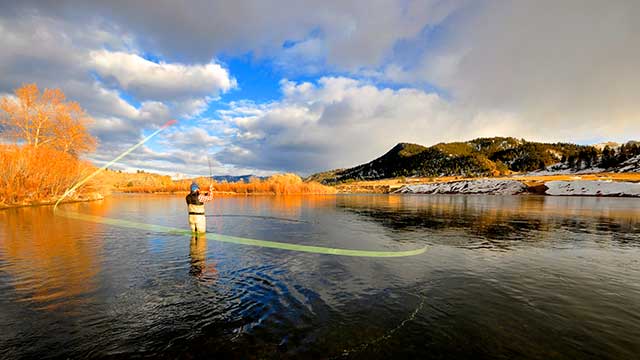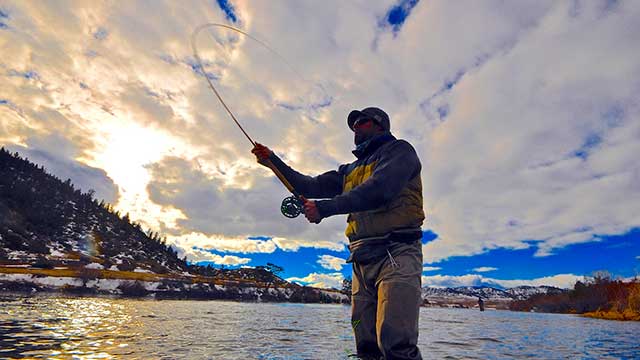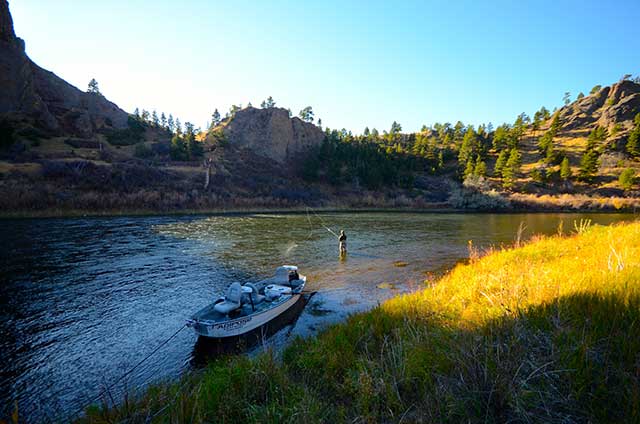The Expanding World of Trout Spey
 You may have overheard a few fellas at your local fly shop talking about two handed rods, trout Spey fishing, and the confusing menagerie of lines. At first you might be saying to yourself, I thought that Spey Rods were for fishing for salmon in the UK or hunting steelhead in the NW. Trout? Who would fool themselves into fishing for a silly 2-pound trout with a 15’ fly rod? Well, welcome to the ever-expanding world of trout Spey.
You may have overheard a few fellas at your local fly shop talking about two handed rods, trout Spey fishing, and the confusing menagerie of lines. At first you might be saying to yourself, I thought that Spey Rods were for fishing for salmon in the UK or hunting steelhead in the NW. Trout? Who would fool themselves into fishing for a silly 2-pound trout with a 15’ fly rod? Well, welcome to the ever-expanding world of trout Spey.
If you have not spent any river time with a two-handed rod I always suggest you find a competent instructor or friend to get your feet wet. It will go a long way in your enjoyment path. To be honest, Spey casting is not as intuitive as learning to single-hand cast. But once you get the hang of it, you’ll be amazed at how uncomplicated it really is.
Trout Spey rods today start at the freakishly fantastic 2 weight on up to the very capable 5 weight. Rod lengths are quite easy to handle, feeling more like single handed rods than unwieldy longer traditional Spey rods that reach lengths of 15 feet and beyond. The newer rods are available today in shorter and much more manageable lengths. Most are not much longer than your typical 9’ 5-weight. One can find lengths in this category starting at 10 ½ feet up to 12 ½ feet. That is what I believe rods with trout Spey designation fall into. Remember that we are trout fishing, not chasing anadromous fish up and down 100-yard wide coastal rivers. We can only guess as to what we will see in the near future as rod makers expand their two-handed selections.
 I live and fish central Montana where we have several rivers that are designed for swinging flies. Our traditional trout Spey season begins with the BWOs of October and fishes well throughout the BWOs of May. That is what we do here, but what you can do on your local resources is unlimited. For example, it may also be the perfect application for fishing emergers in your summer caddis explosions.
I live and fish central Montana where we have several rivers that are designed for swinging flies. Our traditional trout Spey season begins with the BWOs of October and fishes well throughout the BWOs of May. That is what we do here, but what you can do on your local resources is unlimited. For example, it may also be the perfect application for fishing emergers in your summer caddis explosions.
I fish my Sage ONE 10’9” 2-weight for many months of the year here in central Montana. Most of the time I am swinging soft hackles to emerging or rising, mayfly-chasing trout. The balance of my fishing time is spent blind fishing through riffles and runs and those sexy tail-outs. Leeches are what I lean towards when swinging blind through a run. Smaller buggers and attractor patterns will also interest a few fish along the way.
While I fish Montana’s Missouri river, today’s Spey rods are built for any size stream or river. Modern Scandi and Skagit lines are becoming shorter and easier to cast. The evolution of line design is rapidly making the two-handed game more approachable, attractive, and inclusive than ever before.
You can also fine tune your set-up, allowing you to target specific depths and fishing situations. The number of tips available for Skagit heads is truly mind-blowing. Floating intermediate RIO MOW Tips are available in many sink rates and types, all the way to a fully sinking T-18 tip. Almost any river equation can be solved with the power of Skagit heads coupled with the many tip varieties.
 Scandi systems, on the other hand, are designed to keep the fly closer to the surface. Scandi lines today are a blast to cast, with the ability to create nice, tight loops coupled with ever-so-delicate presentations.
Scandi systems, on the other hand, are designed to keep the fly closer to the surface. Scandi lines today are a blast to cast, with the ability to create nice, tight loops coupled with ever-so-delicate presentations.
Scandi line systems are made for those who like to fish medium weighted flies, light, or unweighted smaller streamer and leech patterns. A Scandi type line will also do well with soft hackles, my favorite fall fly choice. Leave the oversized heavily weighted sculpins at home when fishing a Scandi line.
At Headhunters of Craig, Montana we constantly field phone calls regarding the question of how to apply the trout Spey discipline to their local waters. The answers are plenty and varied.
Here’s a short list of situational rigs, all of them created with RIO’s incredible product line, that you can apply to your home waters:
- Fish a short RIO InTouch Trout Spey Skagit Head with a heavy tip like a T-11 or T-14 to get to those deep buckets on your local creek that nobody ever reaches. Add a short leader and your favorite articulated streamer. You could substitute with RIO MOW Tips for even more options.
- String up a RIO InTouch Trout Spey (Scandi) line with an intermediate RIO VersiLeader to swing buggers and leeches through the heads of riffles looking for those ever-present foraging trout.
- Fool those uncatchable near-surface feeding trout that nobody else can get to bite with a soft hackle. Here’s a great recipe: the RIO InTouch Integrated Trout Spey (Scandi) line outfitted with a RIO Powerflex Plus 12’ 4X leader, a tippet ring, and two staggered softies.
- Stroke a couple of casts through those commonly overlooked pools with the RIO InTouch Skagit Head and an RIO InTouch IMOW Light T-8 5’X5’ tip: 10-foot intermediate tip, the first 5 feet is intermediate and the second 5 feet is T-8. What you get is the ability to get the fly perfectly positioned in front of the fish.











